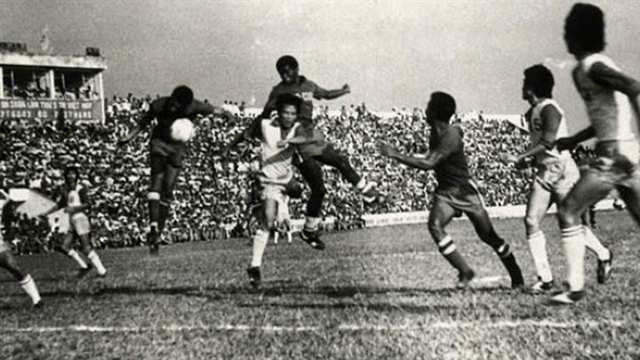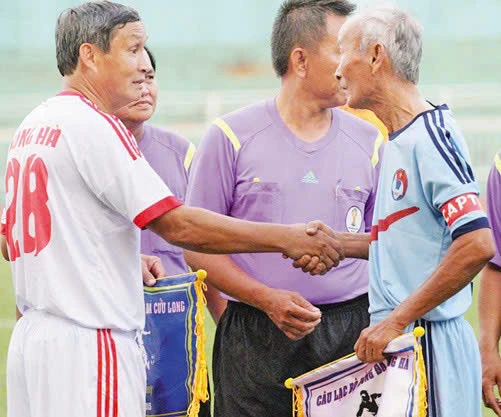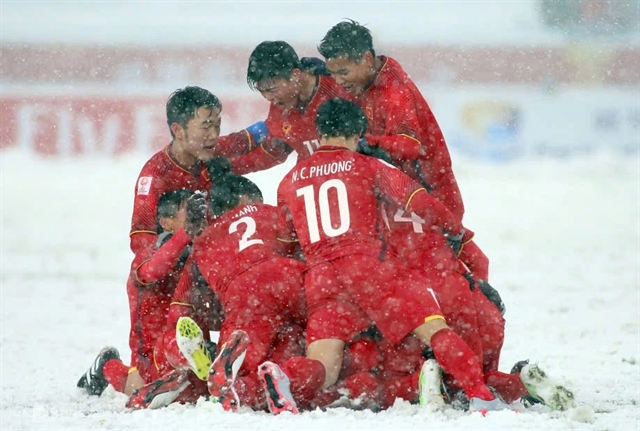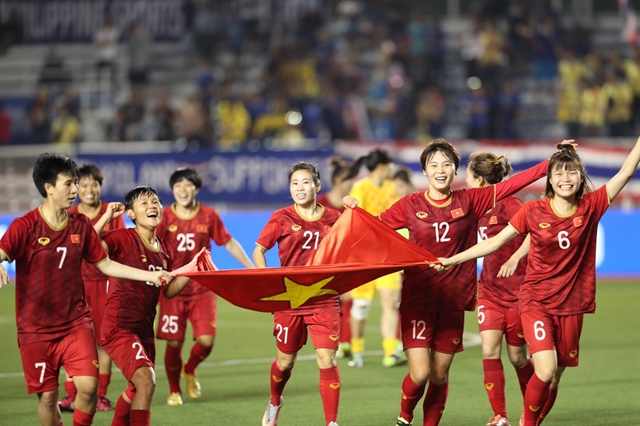As the Vietnamese people celebrate 50 years since reunification, some are reflecting on the remarkable journey of Vietnamese football. The beloved sport has become a powerful symbol of unity and national pride, evolving through each historical period.

North-South football reunion at the Thống Nhất Stadium in HCM City on November 7, 1976. — File Photo of These Football Times
In the wake of April 30, 1975 national reunification, Việt Nam began its reconstruction, and football emerged as a vital bridge between the North and South. A landmark event unfolded the following year when the General Department of Railways team from the north faced off against Saigon Port, the pride of southern football, at HCM City's Thống Nhất Stadium on November 7, 1976.
With over 30,000 spectators in attendance, the match ended in a thrilling 2-0 victory for the General Department of Railways, thanks to goals from Mai Đức Chung and Lê Thụy Hải. This match not only marked a significant moment in football history, but also introduced future legends who would shape the landscape of Vietnamese sports.
Centre-back Phạm Huỳnh Tam Lang led Saigon Port to their first Việt Nam Championship in 1986, while the illustrious Lê Thụy Hải became the first to win the title as both a player and a coach. Meanwhile, Chung emerged as a national icon, guiding the Vietnamese women's team to the finals of the 2023 FIFA Women's World Cup.

Mai Đức Chung (left) reunites after 40 years at the Thống Nhất Stadium in a friendly between the General Department of Railways and Saigon Port. — Photo nhandan.vn
Regional integration challenges
Vietnamese football took a pivotal step in 1991 by rejoining the Southeast Asian community at the 16th SEA Games in the Philippines.
This marked the team’s first international appearance after prolonged wars, yet it came with significant challenges. Poor training conditions, limited equipment, and unfamiliar climates tested the players’ resilience.
Former striker Nguyễn Văn Dũng recalled: “At that time, the training facilities in Hà Nội were extremely lacking.” Upon arriving in the Philippines, players received just two pairs of shoes, one for practice and one for competition, and were bewildered by the concept of buffets.
Amidst these struggles, internal conflicts led to the departure of 11 players, leaving a cloud of regret. Coach Nguyễn Sĩ Hiển said: “While we disagreed with their decision, we understood their reasons.”
Despite the turmoil, the team faced tough opponents, ending the 1991 SEA Games with mixed results: a 2-2 draw with the Philippines and two narrow losses to Indonesia and Malaysia. Yet this experience laid the groundwork for future growth.

Việt Nam were runners-up at the 2018 AFC U23 Championship in China. Photo nhandan.vn
Milestones of progress
From a silver medal at the 1995 SEA Games to a runner-up finish at the 1998 Tiger Cup, Vietnamese football steadily carved out its place in the region.
The year 2000 marked a turning point with the launch of the professional V.League, leading to a historic triumph in 2008 when striker Lê Công Vinh scored the winning goal in the ASEAN Cup.
In recent years, the Vietnamese football scene has flourished, notably during the 2018 AFC U23 Championship in Changzhou, China, where a golden generation of players including Nguyễn Quang Hải and Đoàn Văn Hậu showcased their talent on the international stage. At the event, the Vietnamese team finished runner-up after a tense (and snow-filled) extra time loss to Uzbekistan.
Women’s football deserves special mention as a source of national pride. From humble beginnings, the national women’s team have surged forward, clinching multiple SEA Games championships and making their historic debut at the 2023 Women’s World Cup finals.
Under the guidance of coach Chung, who also played a pivotal role in the "reunification match", the team have etched their name in the annals of sports history.

The Vietnamese women’s team celebrate winning the SEA Games 30. — Photo diendandoanhnghiep.vn
Vietnamese football has not only made waves regionally but has also garnered attention on the continental and global fronts. The Olympic team reached the semi-finals of the 2018 Asian Games, while young talents continually shine in U20 and U23 tournaments. The U20 team even qualified for the World Cup Finals in 2017.
Last year, the U17 team surprised the Asian media by remaining undefeated against formidable opponents like Japan and Australia at the AFC U17 Asian Cup 2024, though they narrowly missed out on a World Cup spot.
Unsung heroes
Behind every success story in Vietnamese football are dedicated coaches who have left an indelible mark. Chung has guided the women’s team to international acclaim, while South Korean coach Park Hang-seo revolutionised men’s football, leading the national team to the final of the 2018 AFC U23 Championship and later stages of 2022 FIFA World Cup qualification.
Following in their footsteps, coach Kim Sang-sik, also from South Korea, has steered the Vietnamese team to a third championship victory at the 2024 ASEAN Cup, defeating arch-rival Thailand.
Fifty years post-reunification, Vietnamese football has made a remarkable journey from humble beginnings to international recognition. The current success reflects the aspirations, determination and unwavering belief of generations past and present.
As the dream of competing on the world stage continues, it will require the collective support of fans, visionary investors and passionate leaders. Football, much like the nation itself, will forever strive to reach new heights. VNS